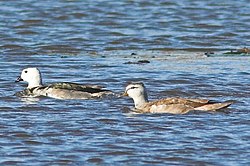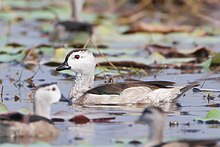Cotton Pygmy Goose
| Cotton Pygmy Goose | |
|---|---|
 | |
| Male (behind), and female, race albipennis | |
| Conservation status | |
| Scientific classification | |
| Kingdom: | Animalia |
| Phylum: | Chordata |
| Class: | Aves |
| Order: | Anseriformes |
| Family: | Anatidae |
| Genus: | Nettapus |
| Species: | N. coromandelianus |
| Binomial name | |
| Nettapus coromandelianus Gmelin, 1789 | |
| Subspecies | |
(Lesser Cotton Pygmy Goose)
(Greater Cotton Pygmy Goose)
| |
The Cotton Pygmy Goose or the Cotton Teal, Nettapus coromandelianus is a small perching duck which breeds in Pakistan, India, Bangladesh, southeast Asia and south to northern Australia.
Description
Small examples are the smallest waterfowl on earth, at as little as 160 g (5.5 oz) and 26 cm (10.5 in). White predominates in this bird's plumage. Bill short, deep at base, and goose-like.
Male in breeding plumage is glossy blackish green crown, with white head, neck, and underparts; a prominent black collar and white wing-bar. Rounded head and short legs. In flight, the wings are green with a white band, making the male conspicuous even amongst the huge flying flocks of the Lesser Whistling Duck, which share the habitat. Female paler, without either black collar and only a narrow or nonexistent strip of white wing-bar. In non-breeding plumage (eclipse) male resembles female except for his white wing-bar. Flocks on water bodies (jheels), etc.
Call: A peculiar clucking, uttered in flight
Distribution
It is largely resident, apart from dispersion in the wet season, but Chinese birds winter further south. It nests in tree holes, laying 8-15 eggs.
This is an abundant species in Asia, although the slightly larger Australian race appears to be declining in numbers.
Found on all still freshwater lakes (jheels), rain-filled ditches, inundated paddy fields, irrigation tanks, etc. Becomes very tame on village tanks wherever it is unmolested and has become inured to human proximity. Swift on the wing, and can dive creditably on occasion.
Behaviour
Its food is chiefly seeds and vegetable matter, especially water lilies; also insects, crustaceans, etc.
The nesting season is July to September (SW. monsoon). Its nest is a natural hollow in a tree-trunk standing in or near water, sometimes lined with grass, rubbish and feathers. It lays 6 to 12 eggs, which are ivory white.




No comments:
Post a Comment